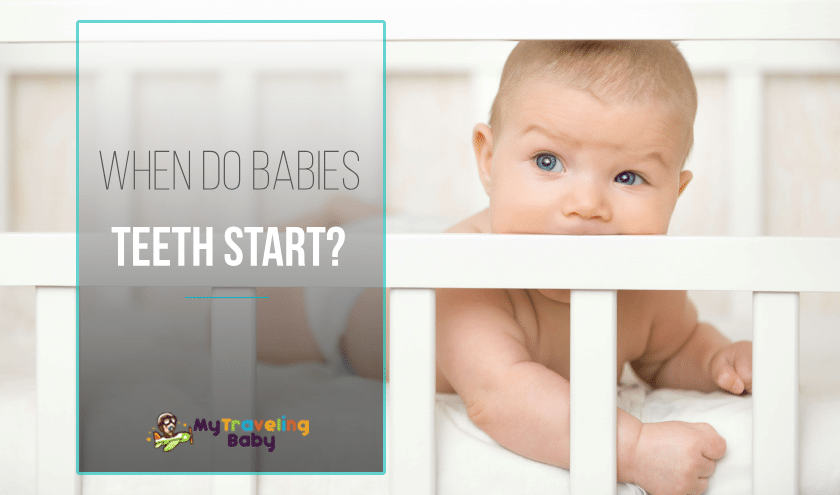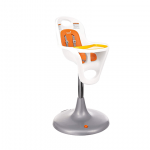
The very first tooth is a significant event in every child’s life. It can, however, be quite uncomfortable. The more a parent knows about the process of teething, the better he or she can assist the baby with going through it.
In this article, we’ll take a look at baby teething symptoms and help you find the best way to treat this discomfort.
When Do Babies Teeth?
Many parents wonder: When will my baby’s first teeth arrive? After all, it’s one of the crucial milestones in every baby’s life. It is also proof that the child is healthy and growing properly.
Just like with the potty training, or starting to eat solid foods, the age varies from one kid to another. Some babies get close to their first birthday before the first tooth arrives. However, the typical age stands at around six months.
From birth, the teeth of every baby are located underneath the gums – they’re just waiting to come out. The time at which they arrive varies, but there is always a pattern. In other words, some come sooner than the other ones.
Furthermore, their emergence is typically symmetrical. This means that the central incisors (front teeth) come in before the lateral incisors (the next set) and so on. To make this easier to understand, we’ve put together a baby teething timeline.
Baby Teething Timeline
· 4-7 months
There’s a good chance that you’ll notice your baby’s first teeth during the first four to seven months of its life. However, they can also arrive as late as 14 months. In most cases, the first tooth is one of the frontal lower teeth. These are also known as central incisors.
Another vital thing to mention here is that signs of teething can appear as early as three months. Don’t be surprised if that happens!
· 8-12 months
The next pair to arrive is the top front teeth. They’re also called central incisors, but this time, they will erupt from the top of the mouth.
· 9-16 months
The next set will appear on either side of the lateral incisors, typically on the top. The ones that follow are the lower lateral incisors. These will be located to the side of the bottom middle teeth.
· 13-19 months
Just after the kid’s first birthday, a parent can expect the arrival of the first molars. These typically start on the mouth’s top part.
· 16-23 months
At this age, the first canines begin to erupt. These have a sharp and pointy appearance.
· 22-33 months
Somewhere around your kid’s second and third birthday, the last gaps will be filled by second molars. Your child will finally have a full set of twenty primary teeth.
Signs Baby is Teething
How to tell if baby is teething? Here are the most common symptoms that every parent should keep an eye on:
· Drooling
Even though it can be hard to believe that so much fluid can come out from a baby’s mouth, teething undoubtedly stimulates drooling. For many children, it starts at around ten weeks to four months of age.
Here’s what to do in case you find out your kid’s shirts being soggy at all times. Make sure to fasten on a bib to keep the baby more comfortable and carefully wipe its chin a few times during the day.
· Rash
In case your child is drooling, this can lead to rashes, redness, chapping, and chaffing around its chin, mouth, and neck. Patting it away can significantly assist in preventing the baby’s skin from taking a hit.
Another thing you can do here is to create a moisture barrier. To do this, use Aquaphor or Vaseline, and also moisturize with an unscented skin cream when required. Make sure to always have some nursing cream at hand, such as Lansinoh.
· Gag reflex/Coughing
The drool that we’ve mentioned can also cause coughing and gagging. However, in case your baby has no other symptoms of allergies or flu, this isn’t a cause for concern.
· Crying
Another symptom is crying. While some babies breeze through teething, some suffer pain that comes with inflammation of gum tissue. Babies share this pain with their parents through crying and whining.
The first teeth typically hurt the most. The same can be said for molars, due to their size. However, most children get used to the feeling of teething and don’t care much for it later on. Consult with your health professional about using pain relievers, such as acetaminophen.
· Biting
The pressure caused by teeth coming through the gums leads to significant discomfort. Some babies relieve this discomfort through counter-pressure – biting and chewing. Children going through this process will gum almost anything, from rattles to mother’s fingers and nipples.
· Refusing to eat
Cranky, uncomfortable babies desire to be soothed by having something in their mouths, like breast or bottle. However, the suction that comes with nursing can cause soreness of the infant’s gums.
Because of this, teething babies can behave quite fussy when it comes to feeding. They can become even more frustrated when they find out that neither their hungry bellies nor their discomfort finds relief. Babies eating solid foods are also prone to refusing to eat during teething. In case the strike lasts longer than just a couple of days, consult your pediatrician.
· Irritability
As the teeth are poking through the gums to get to the surface, your infant’s mouth will ache. Unsurprisingly, this makes children feel quite irritable. They might behave like this for just a couple of hours, but also for days or weeks.
· Night Waking
As your child’s teeth are erupting, the discomfort that comes with it can disturb the baby’s sleeping routine. Before you try to offer some comfort, see if the child can settle itself back to sleep. If this doesn’t happen, try patting or singing lullabies.
In case your baby’s teeth appear slowly, but its hair, skin, and bone growth are normal, there’s probably nothing wrong. But if they don’t appear when the child reaches 18 months of age, make sure to contact your health professional.




